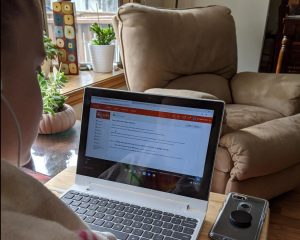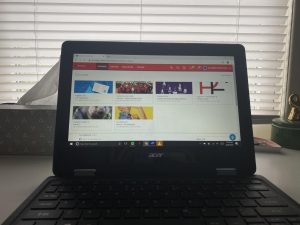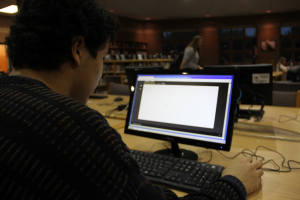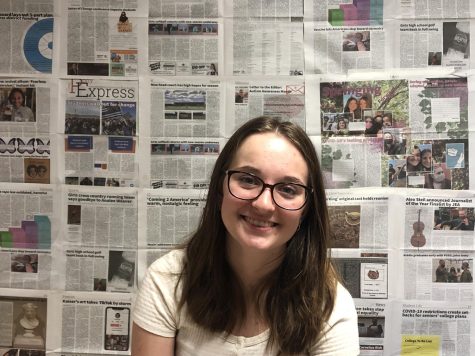C-day, 100% online learning effects remote learners
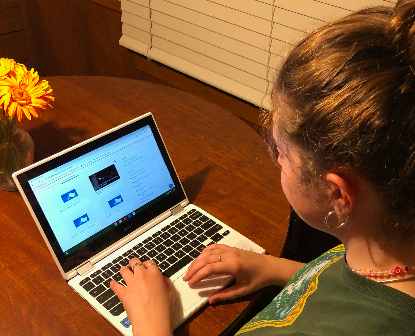
Junior Madeline Stricker learns from home. Although she is enrolled in the B-day hybrid option, she learns from home three days a week on platforms like Schoology and Zoom.
October 28, 2020
For the 2020-2021 school year, students have a new option called C-day, a 100% online learning option to reduce social interactions with other students to prevent COVID-19. Although C-day students have little to no risk of catching COVID-19, their learning and interactions may not be the same. C-day students will have no in-person learning and teachers will not meet students in person. Instruction will be completely online although the platform may mirror the Hybrid model with the Schoology curriculum. One hundred percent of online students have three classes and virtual interaction with teachers.
This year, the C-day option is available to students in any grade and can even be teachers, the option of C-day is available to anyone looking to stay safe from COVID-19, or possibly even looking for more flexibility in their school schedule. C-day students have a three-period schedule like hybrid A and B students and have either hybrid teachers or C-day teachers.
English teacher Jessica Booker, a 100% online teacher, holds “one synchronous lesson a week via Zoom with both English 12 and English 10E. I also do several video lessons a week that I upload onto YouTube and that students have access to from Schoology. This makes me feel like it is a more ‘typical’ school experience, and my students have indicated that they like the video lessons and verbal directions to go alongside the written directions.”
However, science teacher Bryce Ellefson teaches in the hybrid format and holds a weekly zoom meeting for his C-day students during Thursday office hours to work on the lesson, ask questions, check-in, review, and provide social interaction and feedback. Additionally, he uses collaborative discussion forums and assignments for many lessons in which C-day students can interact in the same areas as A or B day students. He has open office hours via Zoom or email on the other days of the week and this is optional for distance learners and hybrid learners.
C-day is a completely new option this year, aside from distance learning last spring, the effectiveness of a completely online schedule is unknown. The type of learner a student is and their ability to comprehend information without as much teacher support a hybrid student may receive will have a considerable impact on the success a student has with C-day.
“I struggle sometimes. I have lots of questions and sometimes teachers can’t answer them that fast. I’ll email that would take like sometimes even days for a response to just one question. Without as much support it is harder than when I was physically in class,” sophomore Kate Sabling said.
Some students have decided to stay home this year for various reasons, some enjoyed the flexibility of distance learning, some stay away from school to reduce their chance of getting the virus, and students or their family members may have underlying health conditions which could increase their vulnerability to the virus. C-day students, however, still have the option to join athletics as all sports are required by the MSHSL to abide by new restrictions to prevent the spread of COVID-19.
“My family and I decided doing school at home would be the safest option. Although I wasn’t concerned about sports this year because I trusted the Athletic Department would give us the necessary guidelines. I also trusted my coaches, teammates, and I would follow the guidelines to keep the team running smoothly. We got many emails about how the Swim and Dive team would look, so I knew ahead of time what the rules were,” freshman Leah Cody explained.
Unlike distance learning last spring, C-day students did not have the opportunity to meet their teachers in person before starting the school year. Although most students and teachers have met over zoom, the student-teacher relationship may not be the same as in previous years.
Booker said this has been the hardest part of having 100% online classes. Last spring when the district had to move into emergency distance teaching, teachers had the benefit of knowing their students and classes so the connections were already there. With 100% online at the onset of the year, there are some students Booker has not gotten to know as well because of the nature of how the learning is taking place. She values the synchronous lessons and office hours she has so she can connect with her students.
In previous school years when school was at full capacity, students had school as a way to make new friends and socialize. Friendships in school are beneficial to students because they can improve emotional skills as well as coping skills and reduce stress levels. C-day students have not had this social option this year which may be difficult for some students who look forward to making and meeting friends.
“I was able to see my friends a few times, but not as often as we usually do. To keep in touch, we do lots of FaceTime calls,” Cody said.
Sabling also uses technology as her main form of communication with her friends, “my friends are also doing online so we hang out but probably like once a month. We just talk over Snapchat or text but not hang out too much”.
Freshman year has also been different than in previous years. Orientation was split into two days for A and B hybrid students, C-day students participating from home. Although for students 100% online it may have been relieving to not have the new pressures of high school quite yet.
Cody said the start of her high school years was nothing she expected. She was not nervous at all because she already knew how Schoology worked, and how most of her classes worked. It was relieving for her because she did not have to think about things like where her classes were or where she would sit at lunch. She does wish she could experience her first year of high school “normally,” though.
Booker has used C-day as an opportunity to improve her teaching skills, “I have had to be adaptable with both my curriculum and how I deliver the content. Many things are simply better equipped to be done in person/in the classroom. For example, I regularly do whole-class discussions and Socratic Seminars. As a result, I have had to explore online resources and utilize the different options that Schoology has to offer. I have asked my students to grant me grace through this process and I have offered the same to them. We are all figuring this out together.”


